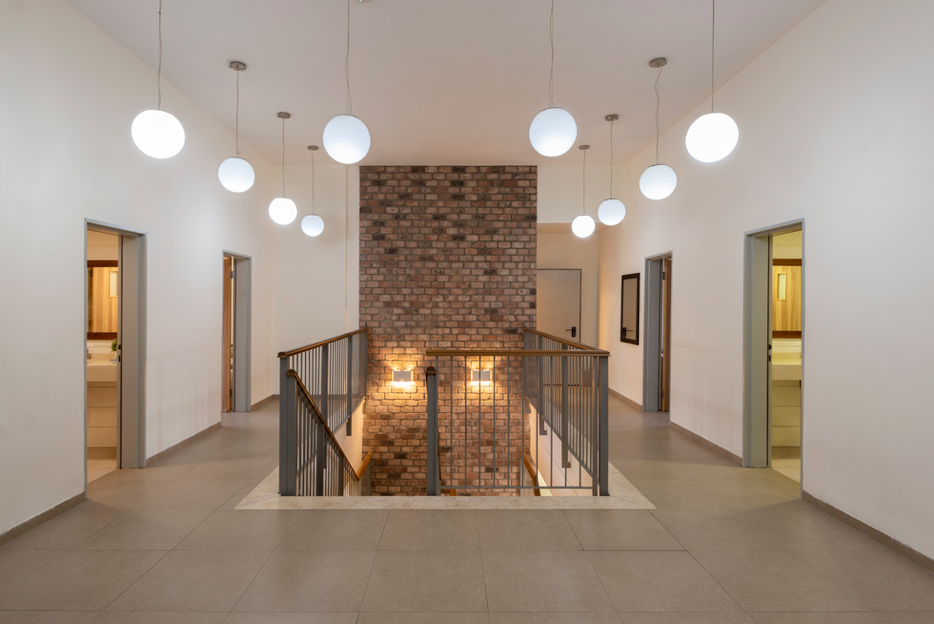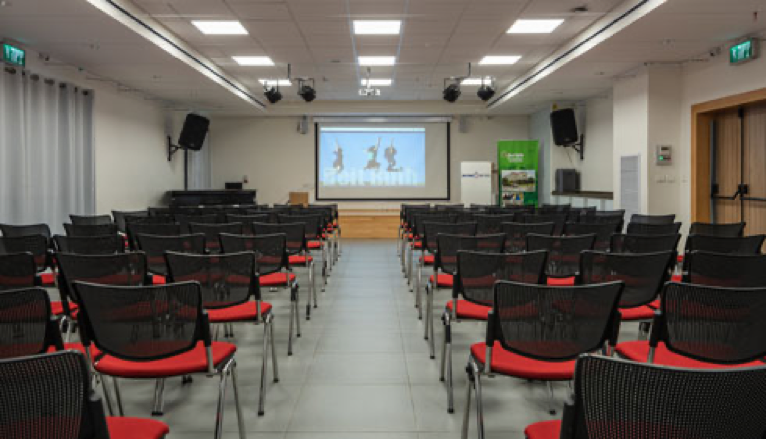Here They Can Breathe Again
“Beit Ruth” provides a home to dozens of girls who have been removed from their home thanks to a generous donation from a woman who was called upon to help teenagers by building an educational and therapeutic Village in the valley — a place that gives hope and life, and the need for it only increases. | 16.09.19 | 08:26 by Michal Blau/מיכל בלאו (Translated from Hebrew)
Beit Ruth, near Afula. 42 girls live here today, and the goal is to meet 150 at a time. (Photo: Lior Grundman)
The upper floor of each dwelling has bedrooms, each of which houses three girls. “There is more privacy,” one of the girls explains. (Photo: Lior Grundman)
Around a long wide table, 14 girls and 5 staff are seated. (Photo: Lior Grundman)
One of the rooms in Beit Ruth. “I loved thinking about a fourth bed for visiting,” says a girl who lives here. (Photo: Lior Grundman)
During their residence in the Village - between three months and six years, and on average two and a half years - the girls are treated by social workers, with individualized treatment plans. (Photo: Lior Grundman)
There is also a school, with an upper floor that overlooks a seating area. More classrooms will be built here in the future. (Photo: Lior Grundman)
Those who come to “Beit Ruth” near Afula see two-story residences with red roofs, lawns, gardens, cobbled paths and a school. A small village. It is not a common place for girls at-risk. “The girls are here 24 hours a day,” says architect Mickey Mansfeld as we tour the complex, “and they have a place to heal.”
The Mansfeld-Kahat Architects’ Office was chosen a decade ago to design “Beit Ruth.” In 2011, the building of three fully-built white residential buildings was completed, and last year the school building was inaugurated here as well. Today, 42 girls live here, and in the future, after the construction of seven more residential buildings is completed, 150 girls will be able to benefit from the unique holistic treatment that takes place here.
They come here by court order due to physical, emotional, and sexual abuse. Most of them dropped out of school, some lost family. Each has a personal story and life events that led her to, in many cases, live on the streets . They arrive at “Beit Ruth,” an environment that allows them to grow, develop, and return to their communities.
“Beit Ruth is a home,” says A., a young woman in the process of joining the Army, who lived at Beit Ruth since she was 13, until she left about a year ago. “Lots of Saturdays I preferred to stay here. Beit Ruth is constantly giving. They are doing everything they can, so it never crosses the girl’s mind that they missed out on anything.”
The Village was founded thanks to a generous donation from Susan and Michael Ashner. (Photo: Lior Grundman)
Ground floor of one of the residences. (Photo: Lior Grundman)
Earth, sky, and greenery — everything they need. (Photo: Lior Grundman)
During their stay in the Village - between three months and six years, and on average two and a half years - the girls are cared for by social workers with individualized plans; they study in small classes (7-8 girls in the classroom), and finish 12 years of schooling (some also receive a high school diploma). They meet other teens from diverse backgrounds; acquire life skills and prepare for military or national service. Once every three weeks, they may leave for a weekend, if they have a safe place to go.
Even after leaving “Beit Ruth,” around the age of 19, the assistance continues - in helping to finance vocational courses (“those that will contribute to their future”), first year’s rent, issuing a driver’s license, and help navigating Israel’s bureaucratic’s maze to inform them of what they can receive from the government. “Above and beyond what every child receives in the State of Israel,” proud Iris Twerski, Managing Director of Beit Ruth, said, “and their achievements are amazing.”
Why boys and not girls?
This special venture was founded in 2006 as a hostel for 12 girls, a rented house in Rishon L’tzion, thanks to the vision of American philanthropists Susan and Michael Ashner. About 15 years ago, the couple took part in a tour to fundraise for boarding houses and hostels in Israel. During the tour, they asked “What about the girls?” The answer they heard – “Girls are quiet and unobtrusive, they don’t need to be taken care of.” Susan didn’t like it. “There’s a problem,” said the philanthropist, who at the age of 16 found herself on the street. “I was like that.” She and Michael decided to do something for at-risk girls.
To date, the two have contributed about $11 million to the establishment and operation of “Beit Ruth,” named after Ruth the Moabite. “The First Convert,” Twerski explains the name; Susan Ashner herself converted to Judaism.
In Beit Ruth, everything is useful. (Photo: Lior Grundman)
Classes and activities are part of what the girls receive here. (Photo: Lior Grundman)
Beit Ruth Managing Director, Iris Twerski: “Our goal is to reach as many girls as we can who are in need. Unfortunately, the waiting lists are heartbreaking.” (Photo: Lior Grundman)
Twerski and Ronit Lev-Ari (formerly the prime minister’s adviser on the status of women and founder of the Center for the Prevention of Domestic Violence) professionally managed the hostel in Rishon L’tzion. “It was a pilot that succeeded,” recalls Twerski. “We sat in a café and started dreaming.”
In 2009, following the joyous success, but not satisfying the demand, Beit Ruth was established as a subsidiary of WIZO, which provided 16 dunams of land (~4 acres) near the Nir HaEmek youth village. “The donor’s condition was that the land be part of the organization,” Twerski notes, “so there would not be a landlord who would suddenly decide that the lease was over.”
The choice of the Mansfeld-Kahat architectural firm was due to the fact that “we were looking for an office with a national name that had experience in public buildings,” according to Twerski. “You couldn’t take risks. If the project failed, hundreds of girls would not have the chance they deserve.” The architects, for their part, were asked to design a welcoming and cozy place that would not resemble the bleak structure of a boarding school. “A sense of a village,” says the architect about the result he sees before his eyes.
Do not compromise on the quality of construction
The Village, which also partners with the Ministry of Welfare and Social Services, is based on shared houses with red tiled roofs (“There was a whole discussion about the roofs,” Twerski says. “We didn’t want anything fashionable; we wanted the appearance of an old Village”). The residential buildings, each of which houses 15 girls, are arranged around a central plaza, including paths and flowering gardens.
There is nothing to showcase here except the services girls receive. The buildings are useful, modest, and simple. “The construction budget was limited,” emphasizes Mansfeld. “We decided not to compromise on the quality of the building and to save things that are luxurious.” When the construction is complete, there will be 10 residential buildings and another building for administrative offices and event halls.” “The Village is stunning,” says A. “There’s everything in it. Who wouldn’t want to stay here?”
Paths of interlocking stones lead from the central plaza to the doors of the buildings, designed as private family homes, in an area of 450 square meters each. On the ground floor are the public spaces - living room, kitchen, and staff rooms. Upstairs are 5 bedrooms, and bathrooms between any two rooms (“the bathroom must be safe and visible”), and the bomb shelter that each modern house in Israel has, where the social worker’s room is located.
Here, there is space to breathe and more privacy, if anyone wants to talk to the staff.
The atmosphere of a family meal
The front door of the house opens to the center of the public space, opposite a staircase built against a brick wall. To the left, a living room, to the right, a kitchen and dining area. The kitchen is large, so the girls can prepare food together, and A. indicates that “it is much more fun to prepare meals here. There is less pressure in the kitchen and more laughs.”
The dining room table is long and wide to create a family atmosphere. At each meal, 14 girls and five staff are seated. Lunch is being prepared by staff. In the living room, sofas and armchairs are scattered about for all the housemates, and there is an exit to the garden. Next to the stairs there is a room for the House Coordinator.
The staircase leads to a wide space, around which the entrance doors open to the private bedrooms. Three girls live in each room. “The rooms are huge, and there is a spacious corner in each one,” says A. “Each room reflects the character of the girls who live in it. The fourth bed in the room is designed to accommodate visitors - a friend or a relative. “I loved thinking about it,” says A.
The influence of the school on the self-image
The school, which is about 1,400 square meters, was designed according to the requirements and standards of the Ministry of Education. In the first stage, it is intended for 75 girls and in the second stage, double that number. It’s better to build two more homes at a time. But the donors were very insistent, and they were right. The structure has an incredible impact on the image of the Village, the self-esteem of girls and their access to education. They realize it’s for them.
A. says that before they built the school, she and the other girls studied in trailers. “We felt like we were in a box of sardines,” she adds. “The first day I went to the new school, I felt I was going back to first grade. I had chills. I had more fun getting up every morning. A school also connected the girls from all of the houses, and we could meet girls we didn’t know before.”
The Village is significantly different from the previous location. (Photo: Lior Grundman)
School room. (Photo: Lior Grundman)
Feeling like a village. (Photo: Lior Grundman)
There was some debate about justifying the establishment of the school. “They insisted and were right,” admits Twersky. (Photo: Lior Grundman)
The shape of the school is like the letter ‘r’ with light and air. The upper floor is longer than the lower and it gives shade to the sitting area, which in the future will become classrooms according to the expected increase in the number of students. The inside of the building is surrounded by concrete roofing, and a wide, long passageway leading to the main entrance. “The transition creates a route and a walking experience,” Mansfeld explains of the design. “We lacked the experience of going to a school we missed out on,” agrees A., “and we got it.”
Both floors are designed in the same way, with a wide hallway on either side of the entrances to the rooms. On the ground floor are offices, a conference room, music classroom, a restroom and a hall for 100 people. Upstairs is a classroom, an art studio, a computer room, a teacher’s room, and an additional restroom.
The size of the classrooms is flexible, thanks to a partition that allows them to be enlarged or reduced in the future. “We never know what the ages of the girls are going to be, and what class size we will need,” Twerski explains. The wide hallway has work stations, seating and leisure areas. “If a girl needs to leave the classroom, she has a comfortable place, a space to go to. A place to sit, relax and rest.”
“Even though the buildings are comfortable and beautiful,” says A., “in the end, if the team wasn’t the way it was, I wouldn’t have accomplished half of what I did at Beit Ruth. There are so many people in the house who want to be with you and love you, and you get carried away and want to be with them.”
“Our goal as a nonprofit,” Twerski concludes, “is that as many young girls who need us will be here. Unfortunately, the waiting lists are heartbreaking. The additional houses that will be built here will help, but will not solve the problem.”

















